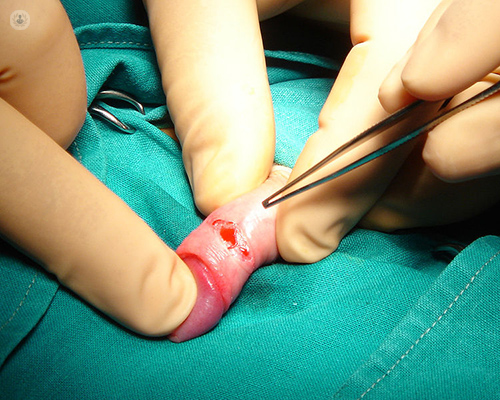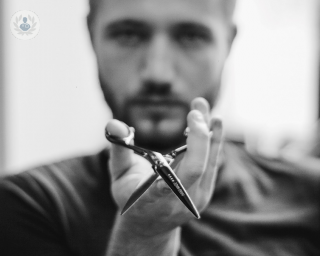Phimosis
Mr Giangiacomo Ollandini - Urology
Created on: 11-13-2012
Updated on: 03-30-2023
Edited by: Carlota Pano
What is phimosis?
Phimosis is a condition that inhibits the foreskin from being able to be pulled over the head of the penis (the glans) because the skin of the foreskin is too tight. The foreskin can appear as a rubber band or tight ring around the tip.
There are two forms of phimosis: physiological or pathological. If it is physiological (congenital or primary), it occurs naturally from birth and separation occurs over time. If it is pathological phimosis (acquired or secondary), it is a result of scarring, infection, or inflammation.

Who does phimosis affect?
Essentially, all newborns have phimosis, but the foreskin loosens naturally over time. It’s common for uncircumcised babies and boys to have phimosis. Until the age of about five, the foreskin normally isn’t retractable. In some boys, this lasts until they are about 10, but it can last throughout puberty.
By the age of 17, boys should be able to pull back their foreskin without pain or discomfort. Adult men can also have acquired phimosis.
What causes phimosis?
Physiological phimosis is naturally occurring, but it is not clear why some boys have this but not others.
Pathological phimosis can be caused by repeated infections or tears. It can occur, for example, when the foreskin is violently and prematurely pulled back in babies. Also, when either the foreskin or glans become inflamed and scarred, the scar tissue contracts and hardens slightly, which causes phimosis. Sexually transmitted infections can put adults at a higher risk of developing phimosis.
Additionally, if the glans becomes sore and inflamed, it is likely that the patient is suffering from balanitis (inflammation of the head of the penis). Certain conditions can increase your risk of developing balanitis, such as diabetes or several skin conditions; eczema, psoriasis, lichen planus, lichen sclerosis.
What are the symptoms of phimosis?
The main symptom of phimosis is the narrowness of the foreskin and difficulty in retracting it. In some cases, there are no notable symptoms. Other associated symptoms, although less frequent include:
- Redness
- Pain during urination
- Swelling or bulging of the foreskin when urinating
- Weak stream of urine
- Blood in urine
- Frequent UTIs
- Bleeding or discharge from beneath the foreskin
- Painful erections
- White ring at opening of foreskin
- Lack of sensation during sexual intercourse
Is phimosis a serious problem?
In most cases, while it may be uncomfortable, the condition isn’t life threatening. You, or your child, should see a doctor when symptoms become obvious - if the foreskin is sore or swollen, or if there is blood, a thick discharge, or an unpleasant smell from under the foreskin.
What are the complications of phimosis?
If phimosis is not treated, complications such as infection or paraphimosis can appear. Paraphimosis is when the foreskin gets stuck behind the head of the penis, causing swelling and pain. It can result in circulation being cut off, and as such, it should be treated as an emergency.
Additionally, if the glans becomes sore and inflamed, it is likely that the patient is suffering from balanitis (inflammation of the head of the penis). This can increase the risks of urinary tract problems.
Men with phimosis are more likely to get penile cancer also. In very extreme cases, it can lead to gangrene and even the loss of the penis.
How is phimosis diagnosed?
Phimosis is diagnosed through a physical exam, medical history, and taking the symptoms into account. If an infection is suspected, a swab or urine test may be taken to be examined in a lab, to determine if it is caused by bacteria or fungus.
What is the treatment for phimosis?
Phimosis is common in children and, therefore in those cases, no treatment is required. The foreskin will loosen naturally.
If phimosis is causing complications, such as paraphimosis or balanitis, it should be treated by an urologist. Antibiotics may be necessary to overcome an infection. Along with gentle daily retraction of the foreskin, topical steroid cream can help to soften the foreskin, making retraction easier.
In more severe cases, partial or complete circumcision or similar surgeries may be recommended, which remove some or all of the foreskin. Local anaesthesia is used in infants, or general anaesthesia in older children or adults undergoing circumcision. The risks associated with circumcision include bleeding and infection.

Can it be prevented?
While physiological phimosis can’t be prevented, pathologic phimosis can be. This is achieved through practicing good hygiene and gentle handling. Some tips to prevent phimosis include:
- Wash the penis regularly with warm water and non-perfumed soap, and dry it thoroughly as part of a daily hygiene routine.
- Wash under the foreskin too, returning it to its normal position.
- Dry under the foreskin, also after urinating.
- Don’t forcibly push the foreskin back, retract it gently.
- Don’t pull the foreskin of a boy or young boy back as it can be painful and damaging
- Circumcision can prevent the reoccurrence.









